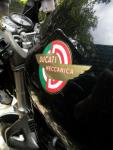Quote:
Originally Posted by 350TSS

7. If soldering as well as crimping, do not pre- tin the cable end before crimping and use the bare minimum of solder – common sense.
|
I would definitely agree with that.
Also I find that, since the connectors are ready-tinned, there is no need to use any extra flux if using multicore solder.
And if its not stating the obvious, crimp the bellows seal AFTER the soldering is done.
In fact, having initially crimped the wire, I then bend the remaining cable slightly away from the metal of the terminal to avoid any heat transfer to the insulation (as far as is possible anyway).
The key to soldering them though is to use a very, very thin bit on the soldering iron, so as to get concentrated heat precisely applied to exactly where you want it.
I have recently done extensive mods to two bike looms using Superseal connectors.
My advice would be .. be wary of any crimped connection.
In theory it may be the best connection but without the exact proper tools and perhaps also a little experience, there will almost certainly be a fair few connections which don't end up being totally secure.
This can easily scupper your efforts .. and rectification is not straightforward as you have already burnt bridges. It can get very frustrating at that point.
I don't want to labour the point too much but I would definitely crimp AND solder all the terminals .. once you've practiced the technique.
For me, the breakthrough was lightly clamping the crimped terminal/wire assembly to a plywood board before soldering (via a soft, rubber pad to prevent damage).
Thus everything is held firm, leaving one hand for the soldering iron and the other for the solder.
There are some very detailed assembly instructions for superseal connectors on the net somewhere.
These have lots of very handy cross-section drawings.
A sharp knife is an excellent tool for scraping away any excess solder .. but with practice you'll get neat enough to rarely need to do that.










 )
)






 Roast Beef Monster!
Roast Beef Monster!

 Linear Mode
Linear Mode

